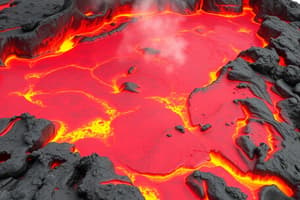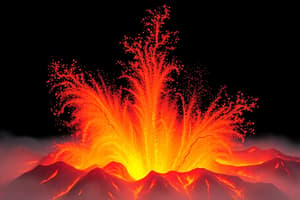Podcast
Questions and Answers
What type of volcano is characterized by steep sides, a symmetrical cone shape, sticky lava, and alternating layers of lava flows, volcanic ash, and cinders?
What type of volcano is characterized by steep sides, a symmetrical cone shape, sticky lava, and alternating layers of lava flows, volcanic ash, and cinders?
- Cinder cone volcano
- Composite/Stratovolcano (correct)
- Caldera volcano
- Shield volcano
Which type of lava has the least explosive nature due to its low viscosity?
Which type of lava has the least explosive nature due to its low viscosity?
- Andesitic lava
- Rhyolitic lava
- Dacitic lava
- Basaltic lava (correct)
What are the roles of volcanoes in Earth's system according to the text?
What are the roles of volcanoes in Earth's system according to the text?
- Providing fertile soil through mineral-rich volcanic ash (correct)
- Decreasing atmospheric oxygen levels
- Creating deserts and arid landscapes
- Causing global cooling by releasing greenhouse gases
Which volcanic region within a rigid plate is characterized by molten rock materials reaching the Earth's surface?
Which volcanic region within a rigid plate is characterized by molten rock materials reaching the Earth's surface?
What determines the nature of a volcanic eruption?
What determines the nature of a volcanic eruption?
Which volcano type is described as having a broad, slightly domed shape and fluid basaltic lava?
Which volcano type is described as having a broad, slightly domed shape and fluid basaltic lava?
What effect does a higher temperature have on the viscosity of magma?
What effect does a higher temperature have on the viscosity of magma?
How does the silica content of magma affect its viscosity?
How does the silica content of magma affect its viscosity?
What happens to the viscosity of magma with a higher amount of dissolved gases?
What happens to the viscosity of magma with a higher amount of dissolved gases?
Which type of magma is likely to result in an explosive eruption?
Which type of magma is likely to result in an explosive eruption?
How does highly viscous magma affect the release of gas during an eruption?
How does highly viscous magma affect the release of gas during an eruption?
What negative effects are associated with pyroclastic flows during a volcanic eruption?
What negative effects are associated with pyroclastic flows during a volcanic eruption?
What is the difference between lava and magma?
What is the difference between lava and magma?
What causes magma to rise to the Earth's surface?
What causes magma to rise to the Earth's surface?
What is the main characteristic of dormant volcanoes?
What is the main characteristic of dormant volcanoes?
What type of volcanic vent emits gases only?
What type of volcanic vent emits gases only?
How is a caldera different from a crater?
How is a caldera different from a crater?
Why does magma rise upward towards the Earth's surface?
Why does magma rise upward towards the Earth's surface?
Flashcards
Composite/Stratovolcano
Composite/Stratovolcano
A volcano with a steep, cone-shaped structure built up by alternating layers of lava flows, ash, and cinders.
Basaltic lava
Basaltic lava
Lava with low viscosity, meaning it flows easily and doesn't erupt explosively.
Volcanoes and Earth's Systems
Volcanoes and Earth's Systems
Volcanoes contribute to Earth's systems by providing fertile soil through the release of mineral-rich ash.
Hot Spot
Hot Spot
Signup and view all the flashcards
Magma Viscosity and Eruptions
Magma Viscosity and Eruptions
Signup and view all the flashcards
Shield volcano
Shield volcano
Signup and view all the flashcards
Temperature and Viscosity
Temperature and Viscosity
Signup and view all the flashcards
Silica and Viscosity
Silica and Viscosity
Signup and view all the flashcards
Dissolved Gases and Viscosity
Dissolved Gases and Viscosity
Signup and view all the flashcards
High Viscosity Magma
High Viscosity Magma
Signup and view all the flashcards
Viscosity and Gas Release
Viscosity and Gas Release
Signup and view all the flashcards
Pyroclastic Flows
Pyroclastic Flows
Signup and view all the flashcards
Lava vs. Magma
Lava vs. Magma
Signup and view all the flashcards
Magma Rise
Magma Rise
Signup and view all the flashcards
Dormant Volcano
Dormant Volcano
Signup and view all the flashcards
Fumarole
Fumarole
Signup and view all the flashcards
Caldera vs. Crater
Caldera vs. Crater
Signup and view all the flashcards
Why Magma Rises
Why Magma Rises
Signup and view all the flashcards




